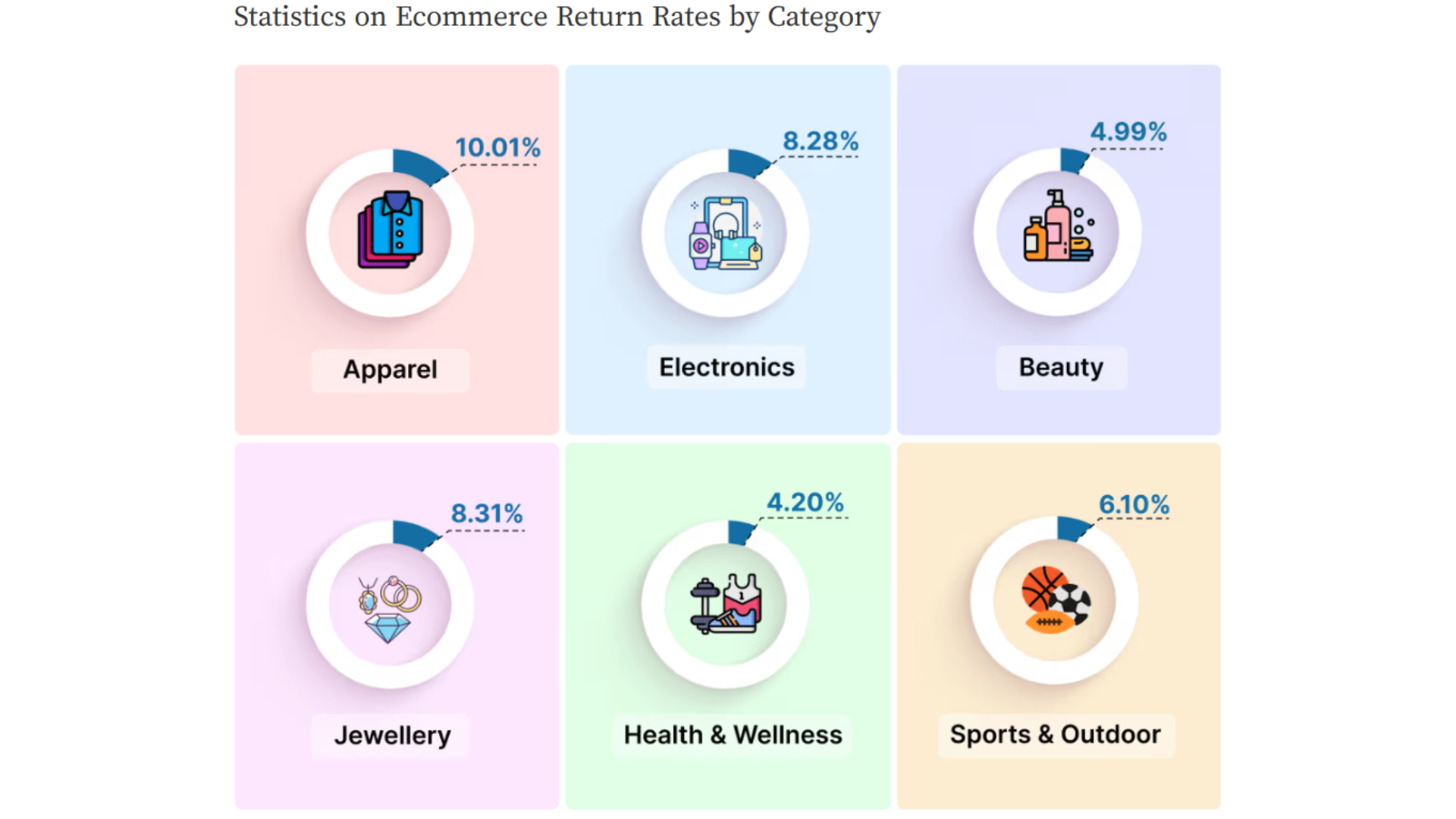- blog
- Statistics
- Ecommerce Return Statistics 2025: Key Trends & Reduction Tips

Ecommerce Return Statistics 2025: Key Trends & Proven Strategies to Reduce Returns
Table of Contents
Picture this: you’re celebrating a successful month with strong sales numbers, only to watch nearly a third of those orders come back as returns. Sound familiar? Nearly 30% of all products bought online are returned, compared to just 8.89% from brick-and-mortar stores. This staggering difference highlights one of the biggest challenges facing ecommerce businesses today.
But here’s the thing – understanding ecommerce return statistics isn’t just about damage control. It’s about unlocking insights that can transform your business, build stronger customer relationships, and ultimately boost your bottom line. Whether you’re a seasoned retailer or just starting your ecommerce journey, these statistics will help you make smarter decisions about your return policies, customer experience, and growth strategy.
Why Your Ecommerce Business Needs a Returns Policy
Let’s be honest – nobody loves dealing with returns. But a well-crafted returns policy isn’t just a necessary evil; it’s actually a powerful tool for building trust and driving sales. Think of it as your safety net that encourages customers to take that final step from “maybe” to “buy now.”
Building Trust Through Transparency
Your returns policy directly impacts customer confidence. 92% of consumers surveyed said that they would buy again if the product return process were easy, whereas 79% of consumers wanted free return shipping. This isn’t just about making returns easy – it’s about removing the psychological barriers that prevent purchases in the first place.
When customers know they can easily return an item if it doesn’t work out, they’re more likely to try new products, explore different sizes, or take a chance on that item they’ve been considering. 67% of shoppers check the returns page before making a purchase, making your return policy a crucial part of the customer journey.
The Conversion Impact
Here’s where it gets interesting: lenient return policies can actually increase sales without necessarily inflating return volume. 27% of consumers would purchase an item online that costs more than $1,000 if offered free return shipping, compared to 10% who would purchase it otherwise. That’s nearly a 3x increase in high-value purchase intent!
The challenge lies in walking that fine line between customer-friendly policies and operational costs. While 49% of retailers offer free return shipping now, businesses must carefully balance the cost of returns against the lifetime value of satisfied customers.
General Ecommerce Returns Statistics Over the Years
Let’s dive into the numbers that define today’s ecommerce landscape. The data paints a clear picture: returns are not just growing – they’re growing faster than ecommerce sales themselves.
Current Return Rate Benchmarks
The average return rate for ecommerce was 16.9% in 2024, according to a report by the National Retail Federation (NRF) and Happy Returns. However, this figure can vary significantly, with industry-wide averages reaching 20% and some categories pushing as high as 30%.
To put this in perspective, the average retail return rate is 24.5% for ecommerce and 8.71% for in-store purchases. This dramatic difference highlights the unique challenges of selling online, where customers can’t touch, try, or fully inspect products before purchasing.
The Financial Reality
The numbers are staggering. Collectively, consumers returned products worth a staggering $890 billion in 2024, with $362.2 billion or 24.5% of online sales revenue lost to returns. Even more concerning? The dollar value of returned online merchandise increased $114.5 billion or 46.2% from 2023 to 2024.
Growing Trends and Future Projections
Ecommerce return rates are expected to grow by $1.4 Trillion by 2025. This growth isn’t just about volume – it’s about changing consumer behaviors and expectations. Reports show that half of Gen Z does this when buying clothes and shoes, while only a quarter of baby boomers do the same when it comes to “bracketing” – buying multiple items with the intent to return some.
Are you struggling to maintain consistent customer communication while managing returns? Salesso’s cold email tools help you reach quality prospects and maintain relationships efficiently. [Try Salesso Now →]
Top Reasons Why Ecommerce Products Are Returned
Understanding why customers return products is your first step toward reducing those returns. The reasons are more predictable than you might think, and most are preventable with the right strategies.
Size and Fit Issues: The #1 Culprit
About half of online returns are due to sizing issues, and this number jumps dramatically for specific categories. According to Statista, size was by far the biggest cause of apparel ecommerce returns last year, with 8 out 10 returns in Fashion ecommerce linked with size and fitting issues.
The problem runs deeper than just picking the wrong size. Nearly half of U.S. shoppers are buying multiple sizes of a product online with the intention of returning some of them. This “bracketing” behavior has become so common that it’s reshaping how retailers think about inventory and fulfillment.
Product Quality and Shipping Issues
80.2% of orders are returned because the product is damaged or broken, making damaged goods a leading cause of returns. This statistic is particularly telling because these returns are almost entirely preventable through better packaging, quality control, and shipping processes.
Wrong items being shipped account for another significant portion of returns, highlighting the importance of accurate fulfillment processes. These operational errors not only cost money but also damage customer trust and satisfaction.
Mismatched Expectations
When products don’t match their online descriptions or photos, returns are inevitable. This category includes everything from colors looking different in person to products feeling cheaper than expected. The challenge is that online shopping removes the tactile experience, making accurate representation crucial.
Category-Specific Return Patterns
The clothing & apparel category in U.S. processes the majority of returns, leading the list with a 26% return rate, while hobby supplies and garden product categories demonstrate a minimal return rate of 6%. This variation reflects the different challenges each category faces:
- Apparel: 20-40% return rate due to sizing and fit issues
- Electronics: 8-11% return rate, often due to defects or buyer’s remorse
- Beauty & Cosmetics: 4-5% return rate, lower due to clearer expectations
- Footwear: 9-17% return rate, primarily sizing-related
🎯 Build Better Customer Relationships
Target the right prospects with verified emails and automated follow-ups
[Try Free] → Boost your outreach success with Salesso
How to Reduce Ecommerce Returns
Now for the good news: most returns are preventable. By implementing smart strategies that address the root causes, you can significantly reduce your return rate while improving customer satisfaction.
Enhance Product Information and Visuals
Your product pages are your frontline defense against returns. Shopify reported a 40% decrease in returns after implementing 3D product visualization, demonstrating the power of better visual representation.
Here’s what works:
- Multiple high-quality photos from different angles and lighting conditions
- Detailed size charts with clear measurement instructions
- 360-degree product views and zoom functionality
- Videos showing products in use or being worn by diverse models
- AR and virtual try-on tools where applicable
The impact of visual technology is remarkable. Virtual try-on solutions, especially for apparel and accessories, can cut returns by an estimated 20-30%.
Improve Packaging and Quality Control
Since around 20% of orders result in damaged or broken goods, investing in better packaging pays immediate dividends. This includes:
- Protective packaging materials appropriate for each product type
- Quality control checks during picking and packing
- Clear handling instructions for shipping carriers
- Return-friendly packaging with easy resealing options
Leverage Customer Feedback and Reviews
95% online shoppers shop again with retailers who provide a good return experience, but preventing returns in the first place is even better. Encourage detailed reviews that include sizing information, and make this feedback easily searchable for future customers.
Smart Return Policy Design
Your return policy should be clear, fair, and accessible. 62.58% of online customers expect retailers to allow returns within 30 days of purchase. Consider these elements:
- Transparent timeframes and conditions
- Multiple return options (mail, in-store, pickup)
- Encourage exchanges over refunds when possible
- Clear cost structure for return shipping
Use Data to Drive Decisions
Track return reasons at the SKU level to identify patterns. This data transforms returns from a cost center into valuable feedback that can improve everything from product development to marketing strategies. Look for trends in specific products, seasons, or customer segments.
Need to follow up with customers post-purchase? Automate your email outreach and customer communication with Salesso’s powerful tools. [Get Started →]
The Future of Ecommerce Returns
The ecommerce return landscape continues evolving rapidly. Two-thirds of retailers introduced return fees last year, mainly because operations and shipping got more expensive. However, this approach carries risks, as customers increasingly expect frictionless return experiences.
Technology will play an increasingly important role in preventing returns. From AI-powered size recommendations to advanced AR try-on experiences, the future lies in helping customers make better initial purchase decisions.
Sustainability concerns are also reshaping return policies, with some retailers implementing “returnless refunds” for low-cost items to reduce environmental impact while maintaining customer satisfaction.
The key is finding that fine line between customer convenience and operational efficiency. Businesses that master this balance will have a significant competitive advantage in the growing ecommerce market.
Conclusion
Ecommerce return statistics reveal both challenges and opportunities. With nearly 30% of online purchases being returned and $890 billion in returns processed in 2024, the stakes have never been higher.
But here’s the silver lining: most returns are preventable through better product information, improved customer communication, and smarter policies. 92% of consumers will buy again if the return process is easy, proving that excellent return experiences can actually strengthen customer relationships.
The businesses that thrive will be those that view returns not as a necessary evil, but as valuable feedback that drives continuous improvement. By implementing the strategies outlined above and staying informed about ecommerce return statistics, you can reduce returns while building stronger, more profitable customer relationships.
Start with one area – whether it’s improving your product photos, refining your size charts, or analyzing your return data – and build from there. Every step toward reducing returns is a step toward higher profitability and happier customers.
Frequently Asked Questions
What is the average ecommerce return rate in 2025?
Why are online return rates higher than in-store returns?
What's the most common reason for ecommerce returns?
How can I reduce my ecommerce return rate?
Do free returns really increase sales?

Target $6.86 Trillion E-commerce Market
Find retail decision makers while browsing – capture contacts from growing businesses
